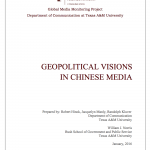Geopolitical Visions In Chinese Media

Geopolitical Visions In Chinese Media.
Author | Editor: Hinck, R., Manly, J., Kluver, R. & Norris, W. (Texas A&M University).
Executive Summary
This study analyzed Chinese web media in an effort to uncover key frames and cultural scripts that are likely to shape potential geopolitical relationships in Asia. The team provided an overview of Chinese media and developed individual reports on cultural scripts in media coverage of three key issues: a) China’s relationships with its regional neighbors, b) the geopolitical dimensions of the “China Dream” (中国梦), and c) Chinese discourse around the “New Style Great Power Relations” (新型大国关系). Data was collected from May to October 2014. Over 2,200 media articles were analyzed from 25 different Chinese media sources controlled for ownership, political slant, official versus, and popular media outlets.
While understanding today’s news agenda will not predict China’s policy over a two decade timeline, the news agenda and media coverage can help uncover deeper components of Chinese political culture, including the world views, assumptions, and geopolitical expectations of China’s leaders. Daily media coverage enacts cultural scripts, and in the case of Chinese media in particular, reflect carefully crafted policy positions agreed upon by Chinese elites behind closed doors. While specific policies can change quite quickly, the underlying societal scripts and political culture are more enduring. Thus, media analysis can help unveil grand narratives of Chinese political visions and capture the underlying national mood which provides constraints to future behavior.
Key Findings
- Chinese foreign policy discourse portrays China as primarily responding to international provocation. While China seeks a stable international environment, it is portrayed as needing to respond to provocative actions committed by others.
- Far from being a threat to the existing geopolitical order, China’s economic and military rise provides opportunities for all nations to benefit.
- The US and its regional allies are portrayed as perpetuating a false China Threat thesis aimed at containing China. The US is seen as the primary enabler of aggressive policies committed by Japan and the Philippines.
- The Chinese media relies heavily on historical allusions to paint Japan as a militant country.
- The US is overwhelmingly the most important and frequently discussed country regarding China’s international relations.
- The China Dream constitutes a domestic and international vision describing China’s peaceful rise promising mutual benefit to all those willing to share in China’s rise.
- The China Dream promises economic prosperity, a return to military strength, emphasizes China’s cultural prestige, and legitimizes the Chinese Communist Parties role in reestablishing China’s greatness following its century of humiliation beginning with the Opium Wars in the 1840s.
- The New Style of Great Power Relations is China’s attempt to avoid the pathologies of historical Great Power conflict with the United States. The concept lays out significant areas for US-China economic and military cooperation, but challenges US policy in the Asia Pacific as failing to live up to the tacitly agreed upon principles of mutual respect and positive relations between the two nations.
Implications & Recommendations
- There is political room for collaboration. In the event that the United States seeks common ground from which to build more cooperative relations with China, this study found evidence suggesting that domestic Chinese media portrayals of some of the most prominent “guiding concepts” that have been articulated by Xi Jinping could provide opportunities that can be leveraged to foster a more cooperative tone in the military-diplomatic relationship.
- US agencies should leverage an understanding of Chinese frames to position US activities for maximum impact by identifying the dominant frames and themes in Chinese media. US engagement with China tends to focus on a different set of frames (such as “responsible stakeholder” or “human rights”) that are at variance with Chinese frames, and thus, US concerns rarely enter Chinese consciousness or are seen as intrinsically oppositional to Chinese priorities. By more explicitly framing US policies within the frames and norms of Chinese media, it might be possible to articulate US concerns to a broader Chinese audience.
- Do not allow counter-productive narratives to go uncontested. US policies are often portrayed in Chinese media in a negative light (i.e., US actions undermine new style great power relations), and this portrayal is rarely countered in US discourse. By understanding how these frames are articulated, it is possible to advance US policies within a framework of collaborative, rather than competitive, ties.
- Proceed with caution and address differences frankly. Although there are areas that might be ripe for greater cooperation, the US would be well- advised to proceed cautiously and be aware of potential rhetorical traps. Specifically, we recommend that any engagement for cooperative purposes that seeks to leverage some of these dominant themes and concepts be proactively defined by the US. Areas of difference in interpretation or emphasis or specific meanings that China might have regarding some of these ambiguous and vague concepts should be directly and forthrightly addressed even as the US might seek to build a more cooperative footing based on some of these ideas.
- Any effort to proceed along a cooperative vector with China is likely going to need broader support beyond just a single US government agency. If the US is looking to actively seek out areas for regional cooperation, we find that there is sufficient material in the Chinese media discourse that can be used to bolster that effort. However, a successful cooperative engagement approach would necessitate a larger US interagency approach to China.

Comments